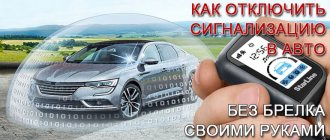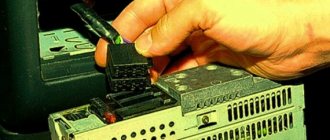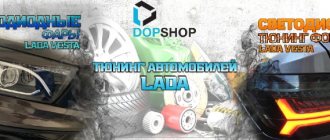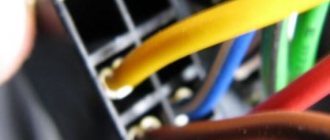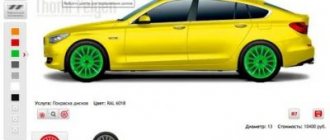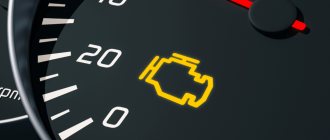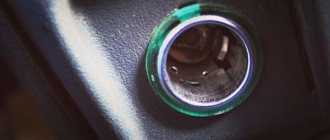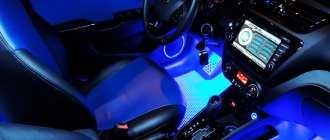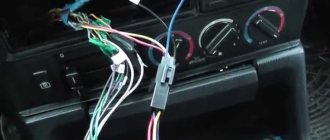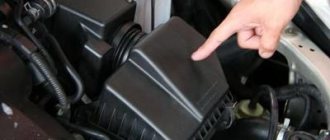I'll start from afar. The beginning is made here www.drive2.ru/l/2952834/
Today I tried to disable the ABS (by pulling out the fuse). And I skated without it in real conditions for half the working day.
So what can I say, when I took out the fuse, I didn’t get a car without ABS, I got a car with a faulty brake system!
The pedal became soft and inadequate, each braking was different from the previous one. Yes, the car began to move wonderfully, but along with the front wheels, the rear wheels also blocked (in short, how to remove the “sorcerer” on VAZs).
I really don’t like the Largus ABS, I don’t like how it works on this particular car. But take my word for it, Largus with abs without a fuse is even worse. And it is also dangerous when turning around during sudden braking.
And there is no need to talk about experience and reaction, surprise happens suddenly (you won’t have time to fart from fear).
After this situation, I decisively and finally turned off the ABS on my Largus, it’s a harmful thing, I checked it on myself today, it didn’t help to brake, I had to throttle to the floor and to the side, otherwise this fool would ruin my handsome car. Of course there was a continuation, she tried to hide, but that was not the case... Her last word was, “I was distracted by the child in the back seat!”
Some reasons to disable anti-lock
The question of how to disable ABS worries motorists driving off-road. The device performed best only on smooth road surfaces. Russian road conditions are far from perfect: the roads are bumpy, snowy, dirty - anti-lock is useless in such cases. Its presence, on the contrary, aggravates the situation, increasing the braking distance. No less annoying is the fact that even at low speeds the anti-lock braking system is activated.
Why might you need to disconnect?
Most drivers turn off ABS in conditions where it could do more harm than good: on snowy or sandy surfaces, on icy roads, or when the road surface is covered with holes and potholes. In such conditions, ABS operation increases the braking distance, which can lead to dangerous situations.
Also, disabling ABS may be necessary when its sensors or control unit are not working correctly, which leads to incorrect operation of ABS and threatens emergency situations.
Another reason for disabling the anti-lock braking system is the driver’s desire to use a sporty driving style with controlled drifts and wheel locking.
ABS does not allow you to practice controlled skidding of the car, so you have to turn off the system.
Is it possible to disconnect without consequences?
When thinking about how to disable ABS on a Grant, it is important to remember: “arbitrariness” will lead to some questions during maintenance, which will be visible to the on-board computer technicians. When contacting service during the warranty period, the fact that ABS is turned off is the reason for refusal of free repair.
How to carry out the procedure correctly?
- First, open the mounting block where the fuses are located. It is located near the battery. Sometimes you have to remove the 15-amp fuse, but the car's instructions will help clarify this issue.
- Then the ignition is turned on briefly, and it is important that the brake system and ABS lights do not go out. After the sound signal, the ignition must be turned off.
- Then comes the removal of the block with the bottom cover. The electrical wire from the fuse is cut lengthwise and its ends are stripped to about 2 cm.
The problem of how to disable ABS can be easily solved: you will need a five-pin relay, which can be purchased at any auto store. A thorough study of the contact pattern will help carry out the procedure without negative results.
Work begins with winding contacts 86 and 85. It is necessary to connect the wire going to ground to them. The second wiring is responsible for supplying the signal. The contact marked “30” should connect to the wire coming from the fuse, while 88 should connect to the ABS. The shutdown button can be placed anywhere in the cabin.
Replacing ABS sensors
If the cause of the malfunction is not in the wiring, but in the ABS sensor itself, we replace it. To do this, first unscrew the fastening screw with a Torx T30 key, and then remove the sensor wiring harness from the bracket. The photo shows a Lada Vesta car; on other Lada models the work is performed in a similar way.
Instructions for replacing the front wheel ABS sensor:
Instructions for replacing the rear wheel ABS sensor:
Briefly about the essence of the functioning of anti-locking
Loss of steering control is a common cause of car accidents. Activation of the brake discs occurs when the brake is pressed. Uncontrolled tire skidding leads to loss of vehicle control. The anti-lock design was invented to prevent this situation. When activated, the driver feels the brake pedal pulsate. The main thing here is to correctly use good engineering development.
Why is ABS disabled?
There are times when a car has ABS, but the driver needs to turn it off. The most common option is if the unit or one of the ABS sensors is faulty and driving with the system turned on becomes even more dangerous than without it. The second option is to use the car for recreational and sports driving, for example, for “drifting” on ice or other slippery surfaces.
Some cars allow you to turn off ABS manually by pressing a special button on the dashboard. But such cases are very rare, since most often the manufacturer stipulates that the car should only be operated with the anti-lock braking system turned on.
Now let’s imagine that suddenly on the highway one of your ABS sensors came off and the brake pedal suddenly felt like lead. You stopped the car, listening to the crunching of the anti-lock braking mechanism, and you understand that it will be impossible to drive with ABS turned on, and there are no options to repair it right now. In this case, the easiest way to disable the ABS is to remove the corresponding fuse from the fuse box.
It is important to know that each make and model of car has its own electrical circuit, so in any case you will have to look on the Internet for a fuse map (diagram) for your car. Fortunately, today it is not at all difficult to find it on the Internet. Type into Google “fuse diagram X Y”, where x is the make and y is the model of your car and find the one that is responsible specifically for ABS. After that, carefully remove it from the block and move on.
Features of braking on vehicles with ABS
You can forget about intermittent, smooth braking. The driver does not need to constantly monitor wheel traction. The brake pedal must be pressed not weakly, without sparing any effort. In this case, there is no need to use the motor part. The installation prefers to work independently. In an emergency braking situation, we have to talk about simultaneously pressing the brake and clutch pedals. It is important to disconnect the engine from the transmission. You shouldn't place high hopes on electronics.
The device of the Chevy Niva traction control system. Possible faults
Finally, it has happened; from now on, the Chevrolet Niva includes a safety package - front airbags and ABS. On the one hand, this won’t surprise anyone now, but for a domestic car, which the Chevy Niva essentially is, this is already something. Well, now it's up to the engine. The main thing is that this does not greatly affect the price, because even now it is no longer small...
General information
The automatic brake release system (ABS system) is designed to increase vehicle stability under heavy braking conditions or when driving in poor road conditions. This is ensured by the fact that the pressure in the brake circuit is regulated depending on the wheel speed recorded by the sensors.
Actuator
The actuator consists of a master cylinder, an electro-hydraulic pump and 4 solenoid valves.
Warning! ABS systems are supplied by Bosch and Nippondenso. The actuator of the Bosch system has a monoblock design and contains a built-in processor control unit and a solenoid valve relay, whereas in the Nippondenso system these components are mounted separately.
The electric pump is designed to pump fluid into the actuator receivers, through which fluid under pressure is supplied to the brake circuit.
Solenoid valves control the pressure in the brake circuit when the ABS system is activated, the valve block contains 4 valves, 1 valve per wheel.
Wheel speed sensors
Rotary type sensors are mounted on each wheel. Signals from the sensors are sent to the control unit.
The front sensors are mounted on the steering knuckle, next to the rotor rings. The rotors are structurally combined with the front outer CV joints of the axle shafts.
The rear sensors are mounted on the rear axle brackets, the rotors are structurally integrated with the rear hub.
ABS control unit
The Nippondenso system control unit is mounted under the front partition of the body, the Bosch system control unit is mounted in the actuator. The unit receives signals from the brake light switch and the speed sensors of each wheel. These signals are the initial data for adjusting the pressure in the hydraulic drive of a given wheel. The control unit also has a self-diagnosis and fault memory function.
If the system fails, the warning lamp on the instrument panel lights up, and a failure code is stored in the memory, which can be read and the nature of the malfunction or the faulty unit determined.
About the most common causes of breakdowns
The ABS light comes on on the dashboard, extraneous noise is heard in the brake unit, the brake pedal has become too soft, which means there is a high probability of a serious malfunction. Initially, the car owner will have to make sure that there is no air in the brake system, that there is no oil leakage, and that the brake fluid level is normal. What “diseases” do you encounter at a service station?
- Wheel sensors don't want to work.
- Elements are damaged mechanically.
- The ABS pump has gone out of operating mode.
- The control unit has failed.
- This last difficulty raises many nuances.
Despite the difficulties, it is worth thinking carefully about whether disabling ABS is justified specifically for the car owner. When deciding to take such a step, you need to weigh the pros and cons and take a closer look at the driving conditions. The criteria are largely predetermined by the intricacies of the particular road along which the “steel horse” is often forced to travel.
Temporary blocking of the anti-lock braking system
If you don’t want to perform all of the above steps, and the car is driven exclusively on hard and level surfaces, disabling the ABS may not be necessary. Before disabling ABS in the manner described above, you should be aware that under normal conditions it can actually reduce braking distances, leaving control of the vehicle to the driver. In addition, knowing some of the subtleties of control, in any emergency situation you can simply block its operation without first turning it off.
A fairly common situation when the anti-lock braking system prevents the car from stopping quickly is the need for emergency braking on a slippery, snowy road when an obstacle suddenly appears. In this case, when pressing the brake pedal does not lead to the desired result, and there is no time to turn off the system with the button, you should sharply pull the handbrake, blocking the rear wheels of the car. With this behavior of the driver, the system will allow you to fully depress the brake pedal, and you will be able to stop the car much faster. Thus, the question of whether it is possible to disable ABS should be accompanied by another one - whether this should be done, but each driver will have to decide it independently.
Good afternoon friends! Today I turned off ABS by turning off fuse F19. The ABS turned off, but the speedometer also turned off along with it!!))) Tell me how else you can turn off the ABS so that the speedometer and something else don’t turn off).
From the forum administration:
Any interference with the brake system is prohibited! You must remember this!
Operation of such a vehicle is PROHIBITED!
Such a car will not pass inspection and its owner may be held liable in accordance with traffic rules and the code of administrative offenses!
“Bringing to life” the control unit
Failure to operate the unit is a consequence of contact burnout, which is caused by increased voltage. The second reason that there is no contact is mechanical or chemical influence. With a thoughtful approach, repairing the ABS unit is simple. Having conveniently positioned the part on the workbench, you need to carefully open the body using a construction knife. You shouldn’t run it too deep, otherwise you can damage the electrical wires.
Having identified the break point, using a pulse soldering iron, the damaged wires are resoldered. You can use a Weller soldering station. It is not recommended to overheat the ceramic base to avoid damaging the board. A damaged board will require replacement. After this, all that remains is to assemble the block and install it back.
The problem is not always the block. Sometimes you have to change the sensors located on the rims. If you want to restore the functionality of the old device yourself, without resorting to installing a new one, it becomes necessary to rewind the coil built inside the sensor. The work of restoring the system is thankless, so it is recommended to contact service centers. This will save a lot of effort, nerves and money.
Sanek-Surgut » 13.02.2010 21:38
Re: how to disable ABS
Vlad01 » 14.02.2010 2:39
Re: how to disable ABS
alekom777 » 14.02.2010 8:02
It is enough to pull out the fuse responsible for the ABS and that’s it.
Abs is a good thing, you shouldn’t be so upset about it. It makes it possible to steer when the wheels are locked. Without ABS, the wheels stand up like a stake and even if you turn the steering wheel, it will continue to drive as straight as it should. The first year I swore at it myself, then I learned to use it and everything was fine. Tip: If you need to brake and the wheels are stuck and the ABS is working, press the brake pedal even harder. The harder you push, the more effective the braking.
Re: how to disable ABS
BlackPrince » 14.02.2010 9:24
Re: how to disable ABS
TAX » 14.02.2010 11:58
14.39. ABS: the natural choice
The purpose of ABS is simple to formulate – it prevents the wheels from locking when braking. Is the brake pedal pressed too hard? No problem - the electronics, comparing the signals from the rotation speed sensors on each wheel, determines the moment when the wheel suddenly stops and, by opening the solenoid valve, releases excess pressure from the brake line into a special hydraulic accumulator. The brake pads are released, wheel rotation is restored, the valve reconnects the line to the pressure that the driver's right foot creates with the help of a vacuum brake booster. And if this pressure is still too high, then the cycle repeats again and again. In the cabin, the activation of ABS is manifested by a crackling noise during operation of the executive unit and jolts on the brake pedal, more or less noticeable depending on the design of the system. In fact, ABS imitates the actions of an experienced driver who, on a slippery road, avoids wheel locking by using intermittent braking. But the ABS does this with a frequency and accuracy inaccessible to humans - up to 15 times per second.
It would seem that everything is already clear. Anti-lock braking systems are recognized by the entire civilized automobile world and have already become standard equipment on cars, starting from the middle class. But voices of dissatisfaction are often heard.
“No electronics can compare with an experienced driver,” some say. “Give me the same car without ABS, and I’ll stop earlier!”
In order to put everything in its place, we resorted to a technological crime. We found a plug under the hood that fits into the ABS control unit and pulled it out of the socket, causing the yellow ABS control to light up and the red brake light in the instrument cluster to blink alarmingly. So we deactivated the non-disabled anti-lock braking system. The tests were carried out according to this scheme. We chose four main exercises: braking on a straight line - on homogeneous and mixed surfaces (mixed), while turning and while avoiding an obstacle (that is, when performing a rearrangement maneuver). The Passat was equipped with recording equipment that accurately measures speed and braking distance. And our test experts were behind the wheel. However, some of the exercises were also offered to ordinary drivers of various qualifications - from a novice car enthusiast to an experienced professional. Everyone could practice before the test runs, get used to the car and “shoot” for the next maneuver.
Each exercise was performed in two series. First, they made more than ten runs with the ABS working, then they turned off the system, and the car again hurried to the route of the next maneuver marked with bright markers.
With the anti-lock braking system, everything is simple: if you want to get the maximum possible deceleration, put the pedal to the floor without thinking twice. How to brake without ABS?
At first we tried to do everything “according to theory” - braking to the point of locking the wheels. Does not exceed! The too sensitive Volkswagen pedal does not allow precise dosing of the braking force - and we make mistakes, both in one direction and the other. And this is in a calm environment. Just try to do this in an extreme situation when an accident threatens!
